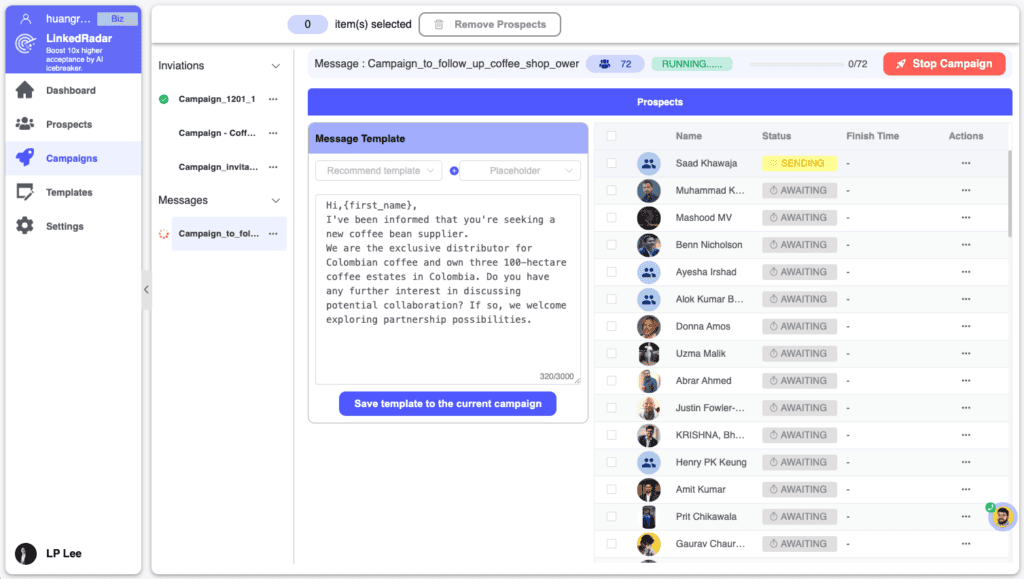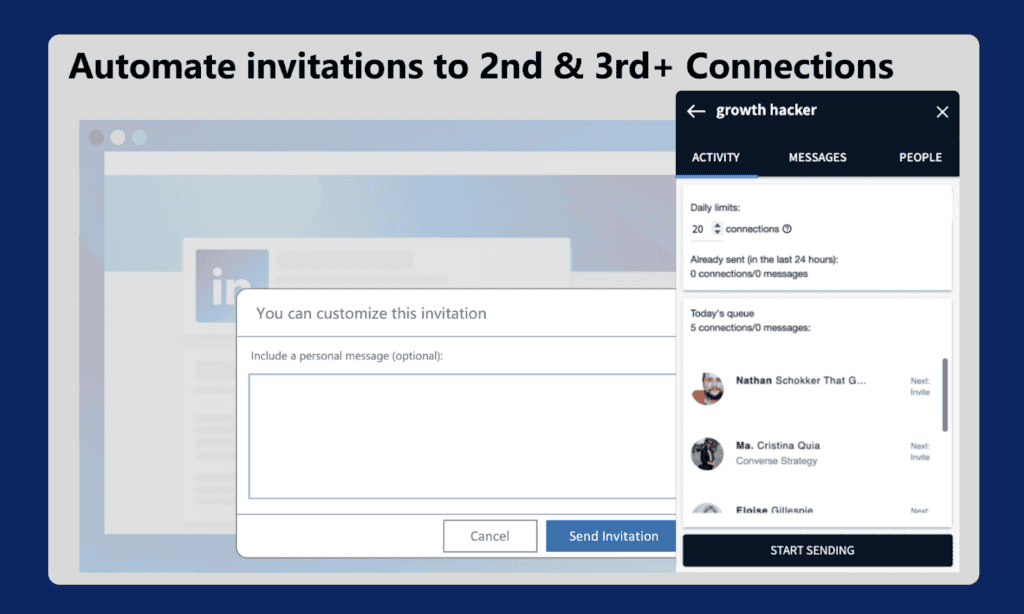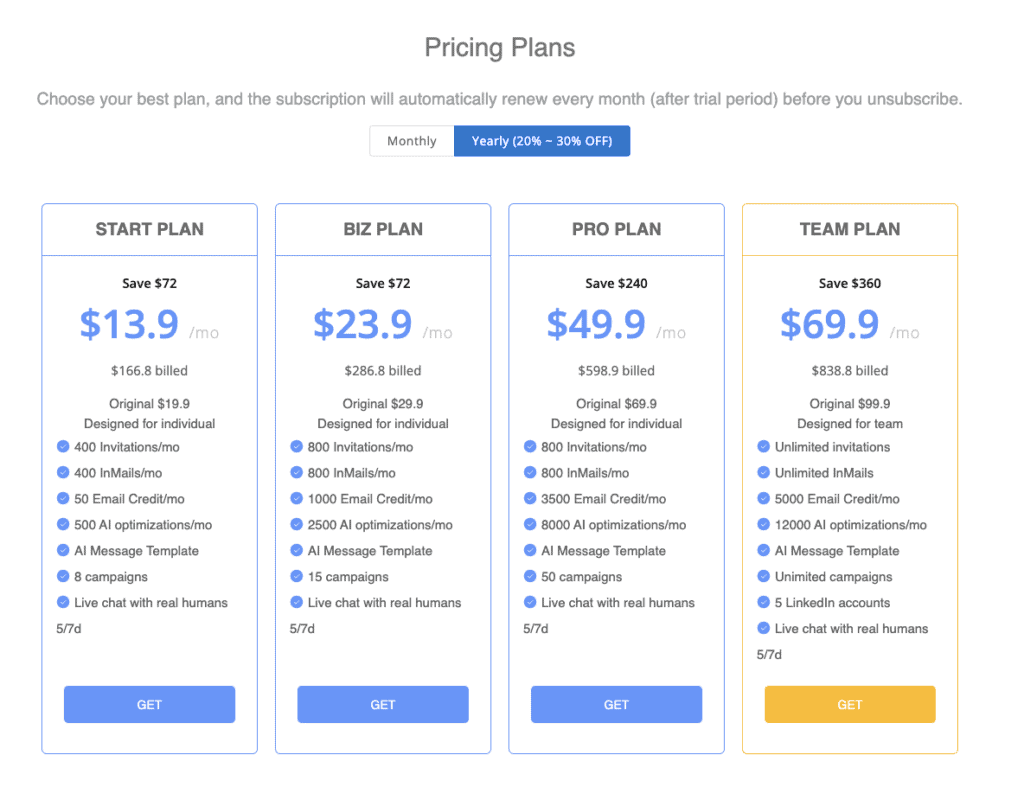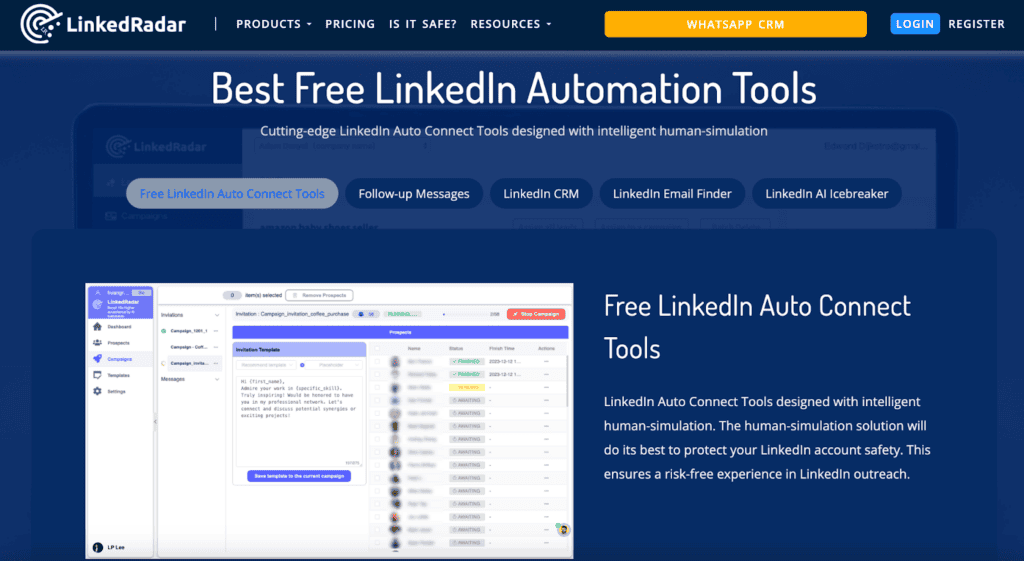When it comes to automating your LinkedIn outreach, there are many tools on the market, and Linked Radar is one of them. It promises to simplify lead generation by automating tasks like sending connection requests, follow-up messages, and even managing InMail campaigns. While this might sound like a solid option for LinkedIn users, after spending some time with Linked Radar, I realized that it lacks several critical features that modern businesses need for effective LinkedIn automation.
In this article, I’ll break down my experience using Linked Radar, discuss its key features, and explain why tools like Aimfox are far better options if you’re looking to maximize your LinkedIn outreach and lead generation efforts.
What is Linked Radar?
Linked Radar is a LinkedIn automation tool designed to automate basic LinkedIn tasks like sending connection requests, managing follow-ups, and sending InMail messages. It’s targeted at marketers, sales professionals, and recruiters who want to save time on manual LinkedIn outreach.
At first glance, it appears to offer many of the same features as other LinkedIn automation tools, but after using it for a while, it became clear that Linked Radar falls short in several areas that are critical for anyone looking to run sophisticated and data-driven LinkedIn campaigns.
Key Features of Linked Radar
Basic LinkedIn Automation
Linked Radar offers basic LinkedIn automation features, including sending connection requests, follow-up messages, and InMail messages. While these are essential tasks, Linked Radar’s approach is far too simple for anyone looking to build more advanced, nuanced campaigns.
Unlike Aimfox, which provides dynamic workflows and smart triggers, Linked Radar is limited to basic, linear automation. You can set up sequences, but you won’t be able to add conditional logic or advanced message sequences that change based on how your leads interact with your outreach. If you want your campaigns to feel more personalized and responsive, Linked Radar will quickly feel too rigid and simplistic.
Personalization Options
While Linked Radar does offer some personalization options, such as inserting names and job titles into messages, these capabilities are basic at best. For LinkedIn automation to be truly effective, your messaging needs to feel personalized and tailored to the individual recipient’s situation.
Aimfox, on the other hand, allows for deep personalization, letting you adjust not only the content of your messages but also the timing and sequence based on user behavior. Linked Radar’s lack of dynamic personalization severely limits its effectiveness in making outreach feel genuine and customized, which is critical in building relationships on LinkedIn.
Analytics and Reporting

Analytics is an area where Linked Radar really underdelivers. While it offers basic metrics like the number of connection requests sent and acceptance rates, it lacks the detailed analytics necessary to track the performance of individual message sequences or identify where your campaigns may be falling short.
In comparison, Aimfox provides in-depth reporting that helps you break down every part of your outreach, including message response rates, where leads drop off, and how well your personalization is working. Without these actionable insights, Linked Radar leaves you guessing about what’s working and what isn’t.
Safety and Compliance
Like most modern LinkedIn automation tools, Linked Radar operates in the cloud, which helps minimize the risk of your LinkedIn account being flagged or banned for using automation. This is a nice feature, but it’s also standard in tools like Aimfox, Expandi, and other competitors. Linked Radar’s cloud-based setup helps mimic human behavior, but it’s not enough to set it apart from its competition, especially considering its other weaknesses.
Multi-Account Management
Linked Radar allows you to manage multiple LinkedIn accounts, which is helpful for agencies or businesses running campaigns for several clients or departments. However, the multi-account management feature is clunky and lacks the polish that other tools, like Aimfox, offer. The setup process is less intuitive, and managing multiple campaigns across different accounts feels far less seamless than it should.
User Interface and Ease of Use
Linked Radar’s interface is designed to be simple and user-friendly, which might appeal to beginners. Setting up basic campaigns is relatively straightforward, but as soon as you want to scale your outreach or introduce more complexity into your workflows, the platform starts to feel limited.
More advanced users who are used to creating detailed, customized campaigns will find Linked Radar’s interface too basic. Aimfox, on the other hand, strikes a balance between user-friendliness and advanced features, making it a better fit for both beginners and more experienced users.
Pros and Cons of Linked Radar

Pros
- Cloud-based automation minimizes the risk of LinkedIn detection.
- Simple, user-friendly interface for basic tasks.
- Multi-account management for handling multiple LinkedIn profiles.
- Automates essential tasks like connection requests and follow-up messages.
Cons
- Overly simplistic workflows that don’t allow for complex or dynamic campaigns.
- Limited personalization that feels generic and uninspired.
- Weak analytics and reporting that don’t provide actionable insights.
- Multi-account management is clunky and lacks the smooth integration offered by Aimfox.
- No advanced message sequences or conditional logic for smarter outreach.
- Lacks integration with external CRMs or additional platforms, reducing its usefulness for businesses with more complex needs.
Pricing Plans

Linked Radar’s pricing starts at $13.9 per month, which might seem reasonable at first glance. However, when you compare its limited features and lack of customization with other tools like Aimfox, which offers far more flexibility and advanced functionality for a similar price, Linked Radar starts to feel overpriced for what it delivers.
For just a little more money, you can get access to better tools with smarter workflows, deeper analytics, and more effective automation, making Linked Radar a tough sell for anyone serious about LinkedIn outreach.
Who Should Use Linked Radar
Linked Radar might be a suitable choice for beginners or those looking for an entry-level LinkedIn automation tool. If your outreach strategy is relatively simple and doesn’t require dynamic workflows, advanced targeting, or in-depth analytics, Linked Radar could work for you.
However, if you’re serious about LinkedIn outreach and need more control, better personalization, and detailed insights into how your campaigns are performing, Linked Radar is not the right tool. Aimfox offers far more advanced features and is a better investment for users looking to scale their LinkedIn campaigns effectively.
Competitor Comparison: Linked Radar vs. Other LinkedIn Automation Tools
Linked Radar vs. Aimfox
Compared to Aimfox, Linked Radar feels underpowered and overly simplistic. Aimfox provides smarter workflows, advanced triggers, and detailed analytics, allowing users to build more personalized and data-driven campaigns. Meanwhile, Linked Radar’s basic setup and limited features leave a lot to be desired.
Key Differences:
- Automation: Aimfox offers more sophisticated, flexible workflows, while Linked Radar’s automation is rigid and linear.
- Personalization: Aimfox provides deeper, more dynamic personalization, making outreach feel far more genuine.
- Analytics: Aimfox’s analytics are more comprehensive, helping you optimize each part of your campaign, while Linked Radar offers only surface-level metrics.
Verdict: Aimfox is the clear winner for anyone serious about LinkedIn automation, providing far more control, customization, and value than Linked Radar.
Linked Radar vs. Expandi
Expandi is a cloud-based LinkedIn automation tool that offers smart message sequences and highly personalized workflows. It’s designed to allow users to build more advanced campaigns that adapt based on lead behavior, something that Linked Radar simply doesn’t offer.
Key Differences:
- Advanced Automation: Expandi excels with its smart sequences and behavior-based triggers, while Linked Radar sticks to basic, linear workflows.
- Personalization: Expandi’s deep personalization features make it a better option for creating tailored, responsive outreach campaigns.
Verdict: For users looking for more advanced automation and smarter campaigns, Expandi is a better choice than Linked Radar.
Linked Radar vs. Zopto
Zopto is known for its advanced targeting and segmentation features, especially when integrated with LinkedIn Sales Navigator. This allows for more precise lead generation, something Linked Radar is not equipped to handle at the same level.
Key Differences:
- Targeting: Zopto offers more refined targeting options, making it ideal for users who need advanced segmentation.
- Scalability: Zopto is better suited for large-scale outreach campaigns, whereas Linked Radar’s capabilities feel too limited for high-volume users.
Verdict: Zopto is the better choice for users who need advanced targeting and scalability. Linked Radar simply doesn’t compare.
Linked Radar vs. Meet Alfred
Meet Alfred offers multi-channel outreach (LinkedIn, email, Twitter) and combines it with smart automation features. Linked Radar, on the other hand, is strictly focused on LinkedIn, and its lack of flexibility is glaring in comparison.
Key Differences:
- Multi-Channel: Meet Alfred’s ability to integrate LinkedIn, email, and Twitter makes it more versatile.
- Automation: Meet Alfred provides more advanced automation and better multi-channel workflows.
Verdict: For users looking to combine LinkedIn with other outreach channels, Meet Alfred is the better choice.
Linked Radar vs. Dux-Soup
Dux-Soup is an affordable LinkedIn automation tool that offers basic features like connection requests and follow-ups. While Linked Radar also focuses on basic LinkedIn automation, Dux-Soup is much cheaper, making it a better option for users on a budget.
Key Differences:
- Pricing: Dux-Soup is significantly more affordable than Linked Radar, with similar basic automation features.
- Ease of Use: Both tools are simple to use, but Dux-Soup’s lower price gives it an edge for users with basic needs.
Verdict: For users looking for affordable LinkedIn automation, Dux-Soup offers better value for money than Linked Radar.
Final Verdict
While Linked Radar might seem like a decent option at first glance, it quickly becomes clear that it’s too limited for anyone who’s serious about LinkedIn automation. The tool lacks the advanced workflows, deep personalization, and detailed analytics that more robust tools like Aimfox offer.
If you’re looking for a tool that can scale with your business, give you smarter automation, and provide the insights needed to optimize your outreach, Linked Radar just isn’t up to the task. Aimfox offers far more value, control, and features that will take your LinkedIn lead generation efforts to the next level.
Simply put, Linked Radar is too basic, and if you want to stay competitive in your LinkedIn outreach, I’d recommend Aimfox over Linked Radar every time.


